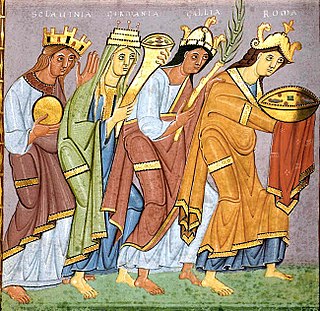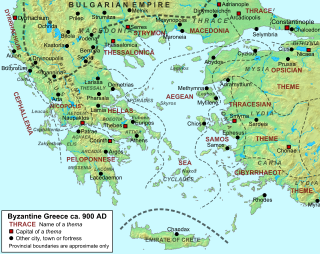
Michael V Kalaphates was Byzantine emperor for four months in 1041–1042. He was the nephew and successor of Michael IV and the adoptive son of Michael IV's wife Empress Zoe. He was popularly called "the Caulker" (Kalaphates) in accordance with his father's original occupation.

Tiberius III, born Apsimar, was Byzantine emperor from 698 to 705. Little is known about his early life, other than that he was a droungarios, a mid-level commander, who served in the Cibyrrhaeot Theme. In 696, Tiberius was part of an army sent by Byzantine Emperor Leontius to retake the North African city of Carthage, which had been captured by the Arab Umayyads. After seizing the city, this army was pushed back by Umayyad reinforcements and retreated to the island of Crete. As they feared the wrath of Leontius, some officers killed their commander, John the Patrician, and declared Tiberius the emperor. Tiberius swiftly gathered a fleet and sailed for Constantinople, where he then deposed Leontius. Tiberius did not attempt to retake Byzantine Africa from the Umayyads, but campaigned against them along the eastern border with some success. In 705, former emperor Justinian II, who had been deposed by Leontius, led an army of Slavs and Bulgars from the First Bulgarian Empire to Constantinople, and after entering the city secretly, deposed Tiberius. Tiberius fled to Bithynia, but was captured a few months later and beheaded by Justinian between August 705 and February 706. His body was initially thrown into the sea, but was later recovered and buried in a church on the island of Prote.

Constantine V was Byzantine emperor from 741 to 775. His reign saw a consolidation of Byzantine security from external threats. As an able military leader, Constantine took advantage of civil war in the Muslim world to make limited offensives on the Arab frontier. With this eastern frontier secure, he undertook repeated campaigns against the Bulgars in the Balkans. His military activity, and policy of settling Christian populations from the Arab frontier in Thrace, made Byzantium's hold on its Balkan territories more secure.

Tyana, earlier known as Tuwana during the Syro-Hittite period, and Tuwanuwa under the Hittite Empire, was an ancient city in the Anatolian region of Cappadocia, in modern Kemerhisar, Niğde Province, Central Anatolia, Turkey. It was the capital of a Luwian-speaking Neo-Hittite kingdom in the 1st millennium BC.

The Battle of Anzen or Dazimon was fought on 22 July 838 at Anzen or Dazimon between the Byzantine Empire and the forces of the Abbasid Caliphate. The Abbasids had launched a massive expedition with two separate armies in retaliation for the Byzantine emperor Theophilos's successes the previous year, and aimed to sack Amorion, one of Byzantium's largest cities. Theophilos with his army confronted the smaller Muslim army, under the Iranian vassal prince Afshin, at Dazimon.

The Sclaveni or Sklabenoi were early Slavic tribes that raided, invaded and settled in the Balkans in the Early Middle Ages and eventually became one of the progenitors of modern South Slavs. They were mentioned by early Byzantine chroniclers as barbarians having appeared at the Byzantine borders along with the Antes, another Slavic group. The Sclaveni were differentiated from the Antes and Wends ; however, they were described as kin. Eventually, most South Slavic tribes accepted Byzantine or Frankish suzerainty, and came under their cultural influences and Chalcedonian Christianity. The term was widely used as a general catch-all term until the emergence of separate tribal names by the 10th century.
Agriculture came to Europe from Asia via the Balkans, which were one of the first areas in Europe to experience the neolithic transformation. As early as 5000 BC the area's Mesolithic population had been transformed into a peasant society of 250,000 people, which in turn grew to 2,000,000 people by the Bronze Age. By then the art of writing had been imported to Greece.
John Kourkouas, also transliterated as Kurkuas or Curcuas, was one of the most important generals of the Byzantine Empire. His success in battles against the Muslim states in the East reversed the course of the centuries-long Arab–Byzantine wars and set the stage for Byzantium's eastern conquests later in the century.

The Byzantine economy was among the most robust economies in the Mediterranean for many centuries. Constantinople was a prime hub in a trading network that at various times extended across nearly all of Eurasia and North Africa. Some scholars argue that, up until the arrival of the Arabs in the 7th century, the Eastern Roman Empire had the most powerful economy in the world. The Arab conquests, however, would represent a substantial reversal of fortunes contributing to a period of decline and stagnation. Constantine V's reforms marked the beginning of a revival that continued until 1204. From the 10th century until the end of the 12th, the Byzantine Empire projected an image of luxury, and the travelers were impressed by the wealth accumulated in the capital. All this changed with the arrival of the Fourth Crusade, which was an economic catastrophe. The Palaiologoi tried to revive the economy, but the late Byzantine state would not gain full control of either the foreign or domestic economic forces.

The Byzantine Empire was ruled by the Isaurian dynasty from 717 to 802. The Isaurian emperors were successful in defending and consolidating the empire against the caliphates after the onslaught of the early Muslim conquests, but were less successful in Europe, where they suffered setbacks against the Bulgars, had to give up the Exarchate of Ravenna, and lost influence over Italy and the papacy to the growing power of the Franks.

The Byzantine Empire, also referred to as the Eastern Roman Empire, was the continuation of the Roman Empire centered in Constantinople during Late Antiquity and the Middle Ages. The eastern half of the Empire survived the conditions that caused the fall of the West in the 5th century AD, and continued to exist until the fall of Constantinople to the Ottoman Empire in 1453. During most of its existence, the empire remained the most powerful economic, cultural, and military force in the Mediterranean world. The term "Byzantine Empire" was only coined following the empire's demise; its citizens referred to the polity as the "Roman Empire" and to themselves as "Romans". Due to the imperial seat's move from Rome to Byzantium, the adoption of state Christianity, and the predominance of Greek instead of Latin, modern historians continue to make a distinction between the earlier "Roman Empire" and the later "Byzantine Empire".

This history of the Byzantine Empire covers the history of the Eastern Roman Empire from late antiquity until the Fall of Constantinople in 1453 AD. Several events from the 4th to 6th centuries mark the transitional period during which the Roman Empire's east and west divided. In 285, the emperor Diocletian partitioned the Roman Empire's administration into eastern and western halves. Between 324 and 330, Constantine I transferred the main capital from Rome to Byzantium, later known as Constantinople and Nova Roma. Under Theodosius I, Christianity became the Empire's official state religion and others such as Roman polytheism were proscribed. Finally, under the reign of Heraclius, the Empire's military and administration were restructured and adopted Greek for official use instead of Latin. Although the Roman state continued, some historians choose to distinguish the Byzantine Empire from the earlier Roman Empire due to the imperial seat moving from Rome to Byzantium, the Empire’s integration of Christianity, and the predominance of Greek instead of Latin.

The Thracesian Theme, more properly known as the Theme of the Thracesians, was a Byzantine theme in western Asia Minor. Created either in the mid-7th or the early 8th century as the settlement of the former Army of Thrace, after which it was named, it was one of the larger and more important themes of the Empire throughout its existence based on its proximity to Constantinople. The Thracesian Theme was one of the longest-lived themes, surviving until the region was conquered by the Turks in the early 14th century.

The Armeniac Theme, more properly the Theme of the Armeniacs was a Byzantine theme located in northeastern Asia Minor.

Mutilation was a common method of punishment for criminals in the Byzantine Empire, but it also had a role in the empire's political life. By blinding a rival, one would not only restrict his mobility but also make it almost impossible for him to lead an army into battle, then an important part of taking control of the empire. Castration was also used to eliminate potential opponents. In the Byzantine Empire, for a man to be castrated meant that he was no longer a man—half-dead, "life that was half death". Castration also eliminated any chance of heirs being born to threaten either the emperor's or the emperor's children's place at the throne. Other mutilations were the severing of the nose (rhinotomy), or the amputating of limbs.

The Theme of Strymon was a Byzantine military-civilian province (theme) located in modern Greek Macedonia, with the city of Serres as its capital. Founded probably by the mid-to-late 9th century, its history as an administrative history was chequered, being variously split up and/or united with neighbouring themes.
Nikephoros Bryennios, Latinized as Nicephorus Bryennius, was an important Byzantine general who was involved in rebellions against the empress Theodora and later the emperor Michael VI Stratiotikos.

Develtos or Deultum was an ancient city and bishopric in Thrace. It was located at the mouth of the River Sredetska on the west coast of Lake Mandrensko, previously part of the Gulf of Burgas, and near the modern village of Debelt.
The term Byzantine Dark Ages is a historiographical term for the period in the history of the Eastern Roman (Byzantine) Empire, during the 7th and 8th centuries, which marks the transition between the late antique early Byzantine period and the "medieval" middle Byzantine era. The "Dark Ages" are characterized by widespread upheavals and transformation of the Byzantine state and society, resulting in a paucity of historical sources.
A reason for the longevity of the Byzantine Empire is how they managed their foreign relations. Armed combat and later its navy were the primary methods with the evolved traditions of the Roman Empire, however Byzantine diplomacy which eventuated with their many treaties was used extensively as well.















